GSK's Organizational Behavior: Culture, Leadership & Tech
VerifiedAdded on 2023/04/17
|19
|6373
|378
Report
AI Summary
This report provides a comprehensive analysis of organizational behavior at GlaxoSmithKline (GSK), comparing its structure and culture with similar organizations like Boots. It examines GSK's flat hierarchical and matrix structures, along with its task-based culture, highlighting the impact on employee motivation and communication. The report explores various leadership styles, including autocratic and participative approaches, and their effectiveness within GSK and Boots. Furthermore, it delves into motivational theories applied at GSK, emphasizing the importance of communication, flexibility, and a positive work environment. The MARS model is used to explain individual behavior, considering internal factors like motivation and ability, as well as external situational factors. Finally, the report discusses the impact of technology on team functioning, emphasizing the need for leaders to adapt and foster collaboration in a technologically driven environment. This analysis aims to provide insights into optimizing organizational performance and employee well-being at GSK.
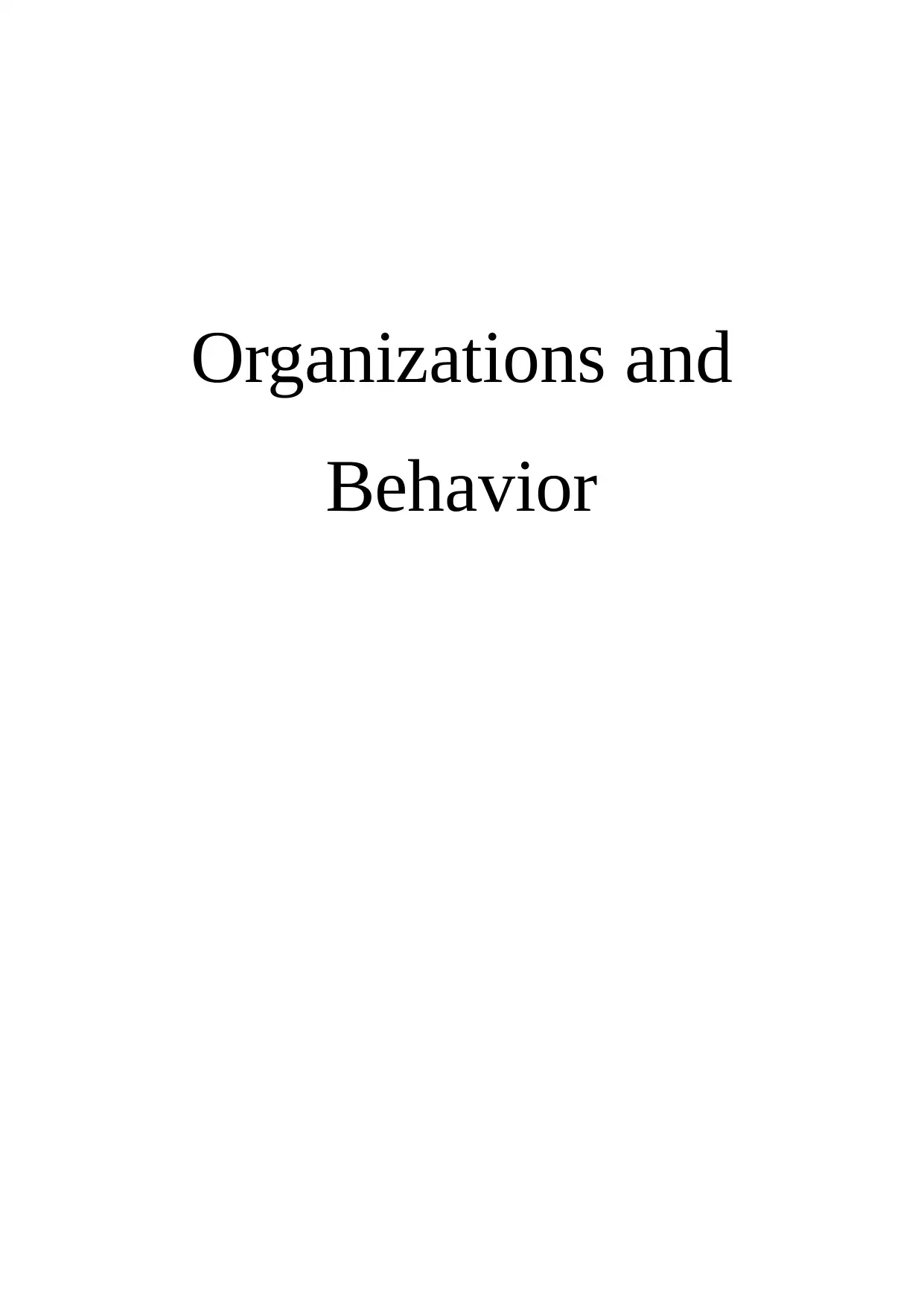
Organizations and
Behavior
Behavior
Paraphrase This Document
Need a fresh take? Get an instant paraphrase of this document with our AI Paraphraser
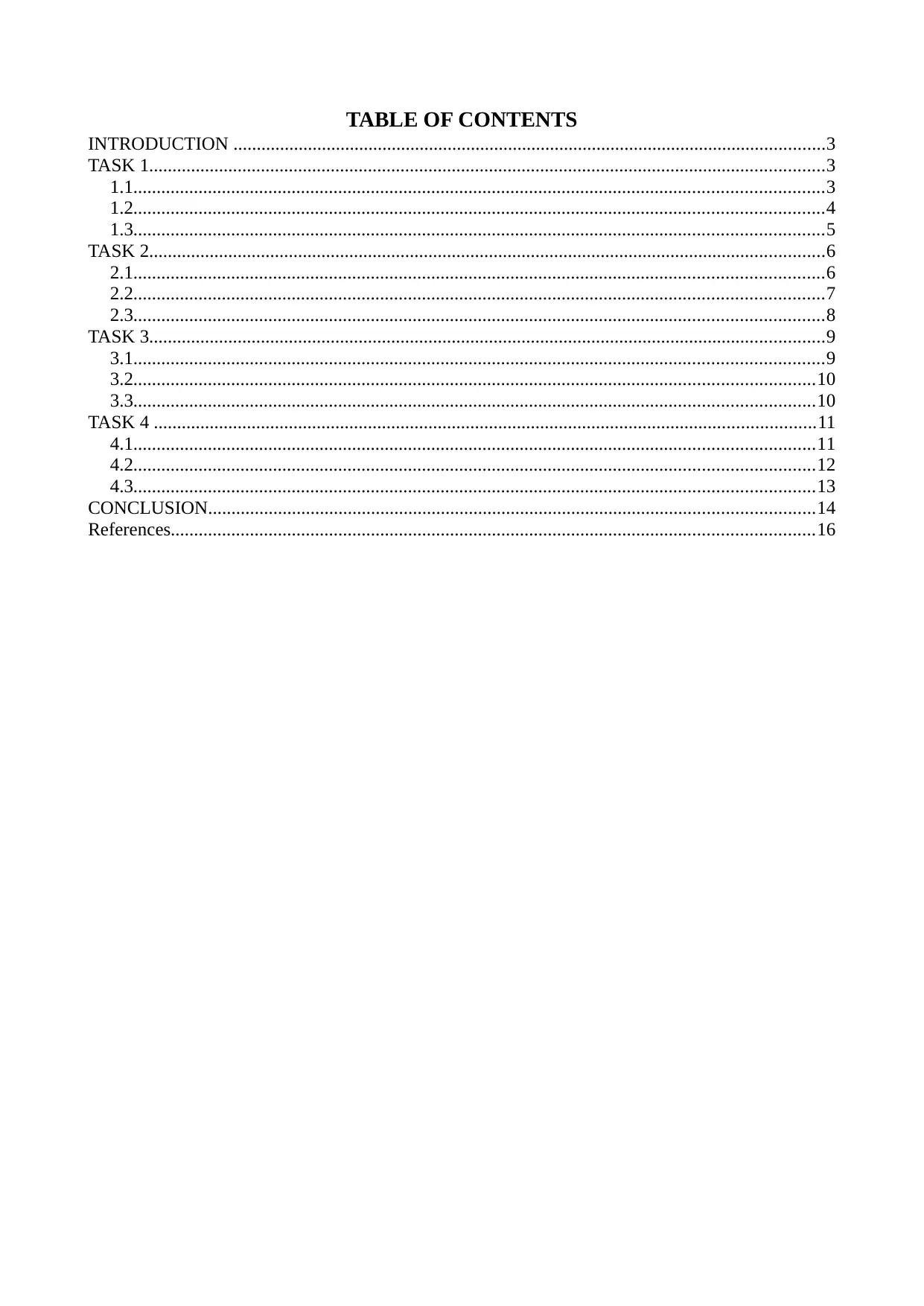
TABLE OF CONTENTS
INTRODUCTION ...............................................................................................................................3
TASK 1.................................................................................................................................................3
1.1....................................................................................................................................................3
1.2....................................................................................................................................................4
1.3....................................................................................................................................................5
TASK 2.................................................................................................................................................6
2.1....................................................................................................................................................6
2.2....................................................................................................................................................7
2.3....................................................................................................................................................8
TASK 3.................................................................................................................................................9
3.1....................................................................................................................................................9
3.2..................................................................................................................................................10
3.3..................................................................................................................................................10
TASK 4 ..............................................................................................................................................11
4.1..................................................................................................................................................11
4.2..................................................................................................................................................12
4.3..................................................................................................................................................13
CONCLUSION..................................................................................................................................14
References..........................................................................................................................................16
INTRODUCTION ...............................................................................................................................3
TASK 1.................................................................................................................................................3
1.1....................................................................................................................................................3
1.2....................................................................................................................................................4
1.3....................................................................................................................................................5
TASK 2.................................................................................................................................................6
2.1....................................................................................................................................................6
2.2....................................................................................................................................................7
2.3....................................................................................................................................................8
TASK 3.................................................................................................................................................9
3.1....................................................................................................................................................9
3.2..................................................................................................................................................10
3.3..................................................................................................................................................10
TASK 4 ..............................................................................................................................................11
4.1..................................................................................................................................................11
4.2..................................................................................................................................................12
4.3..................................................................................................................................................13
CONCLUSION..................................................................................................................................14
References..........................................................................................................................................16
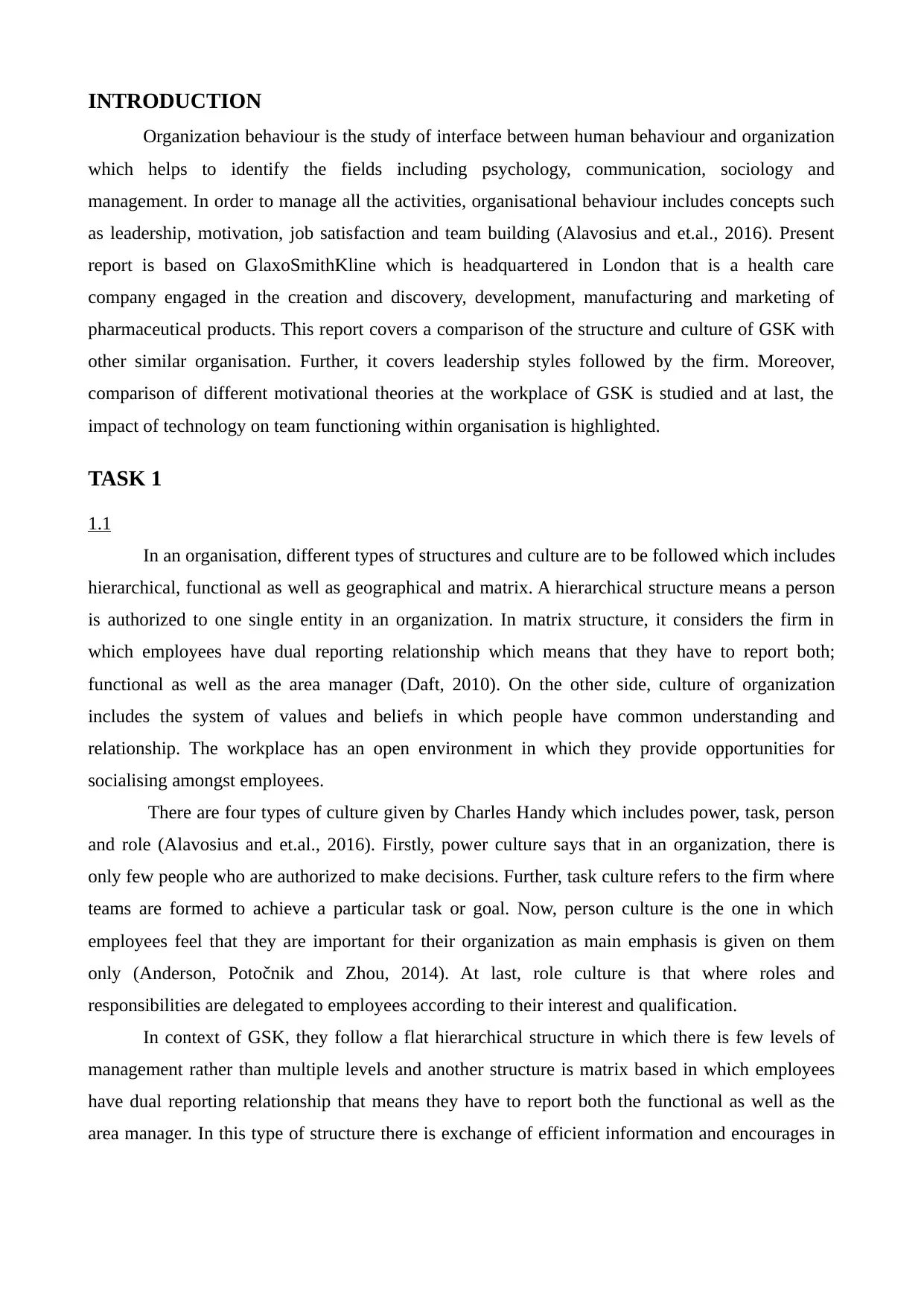
INTRODUCTION
Organization behaviour is the study of interface between human behaviour and organization
which helps to identify the fields including psychology, communication, sociology and
management. In order to manage all the activities, organisational behaviour includes concepts such
as leadership, motivation, job satisfaction and team building (Alavosius and et.al., 2016). Present
report is based on GlaxoSmithKline which is headquartered in London that is a health care
company engaged in the creation and discovery, development, manufacturing and marketing of
pharmaceutical products. This report covers a comparison of the structure and culture of GSK with
other similar organisation. Further, it covers leadership styles followed by the firm. Moreover,
comparison of different motivational theories at the workplace of GSK is studied and at last, the
impact of technology on team functioning within organisation is highlighted.
TASK 1
1.1
In an organisation, different types of structures and culture are to be followed which includes
hierarchical, functional as well as geographical and matrix. A hierarchical structure means a person
is authorized to one single entity in an organization. In matrix structure, it considers the firm in
which employees have dual reporting relationship which means that they have to report both;
functional as well as the area manager (Daft, 2010). On the other side, culture of organization
includes the system of values and beliefs in which people have common understanding and
relationship. The workplace has an open environment in which they provide opportunities for
socialising amongst employees.
There are four types of culture given by Charles Handy which includes power, task, person
and role (Alavosius and et.al., 2016). Firstly, power culture says that in an organization, there is
only few people who are authorized to make decisions. Further, task culture refers to the firm where
teams are formed to achieve a particular task or goal. Now, person culture is the one in which
employees feel that they are important for their organization as main emphasis is given on them
only (Anderson, Potočnik and Zhou, 2014). At last, role culture is that where roles and
responsibilities are delegated to employees according to their interest and qualification.
In context of GSK, they follow a flat hierarchical structure in which there is few levels of
management rather than multiple levels and another structure is matrix based in which employees
have dual reporting relationship that means they have to report both the functional as well as the
area manager. In this type of structure there is exchange of efficient information and encourages in
Organization behaviour is the study of interface between human behaviour and organization
which helps to identify the fields including psychology, communication, sociology and
management. In order to manage all the activities, organisational behaviour includes concepts such
as leadership, motivation, job satisfaction and team building (Alavosius and et.al., 2016). Present
report is based on GlaxoSmithKline which is headquartered in London that is a health care
company engaged in the creation and discovery, development, manufacturing and marketing of
pharmaceutical products. This report covers a comparison of the structure and culture of GSK with
other similar organisation. Further, it covers leadership styles followed by the firm. Moreover,
comparison of different motivational theories at the workplace of GSK is studied and at last, the
impact of technology on team functioning within organisation is highlighted.
TASK 1
1.1
In an organisation, different types of structures and culture are to be followed which includes
hierarchical, functional as well as geographical and matrix. A hierarchical structure means a person
is authorized to one single entity in an organization. In matrix structure, it considers the firm in
which employees have dual reporting relationship which means that they have to report both;
functional as well as the area manager (Daft, 2010). On the other side, culture of organization
includes the system of values and beliefs in which people have common understanding and
relationship. The workplace has an open environment in which they provide opportunities for
socialising amongst employees.
There are four types of culture given by Charles Handy which includes power, task, person
and role (Alavosius and et.al., 2016). Firstly, power culture says that in an organization, there is
only few people who are authorized to make decisions. Further, task culture refers to the firm where
teams are formed to achieve a particular task or goal. Now, person culture is the one in which
employees feel that they are important for their organization as main emphasis is given on them
only (Anderson, Potočnik and Zhou, 2014). At last, role culture is that where roles and
responsibilities are delegated to employees according to their interest and qualification.
In context of GSK, they follow a flat hierarchical structure in which there is few levels of
management rather than multiple levels and another structure is matrix based in which employees
have dual reporting relationship that means they have to report both the functional as well as the
area manager. In this type of structure there is exchange of efficient information and encourages in
⊘ This is a preview!⊘
Do you want full access?
Subscribe today to unlock all pages.

Trusted by 1+ million students worldwide
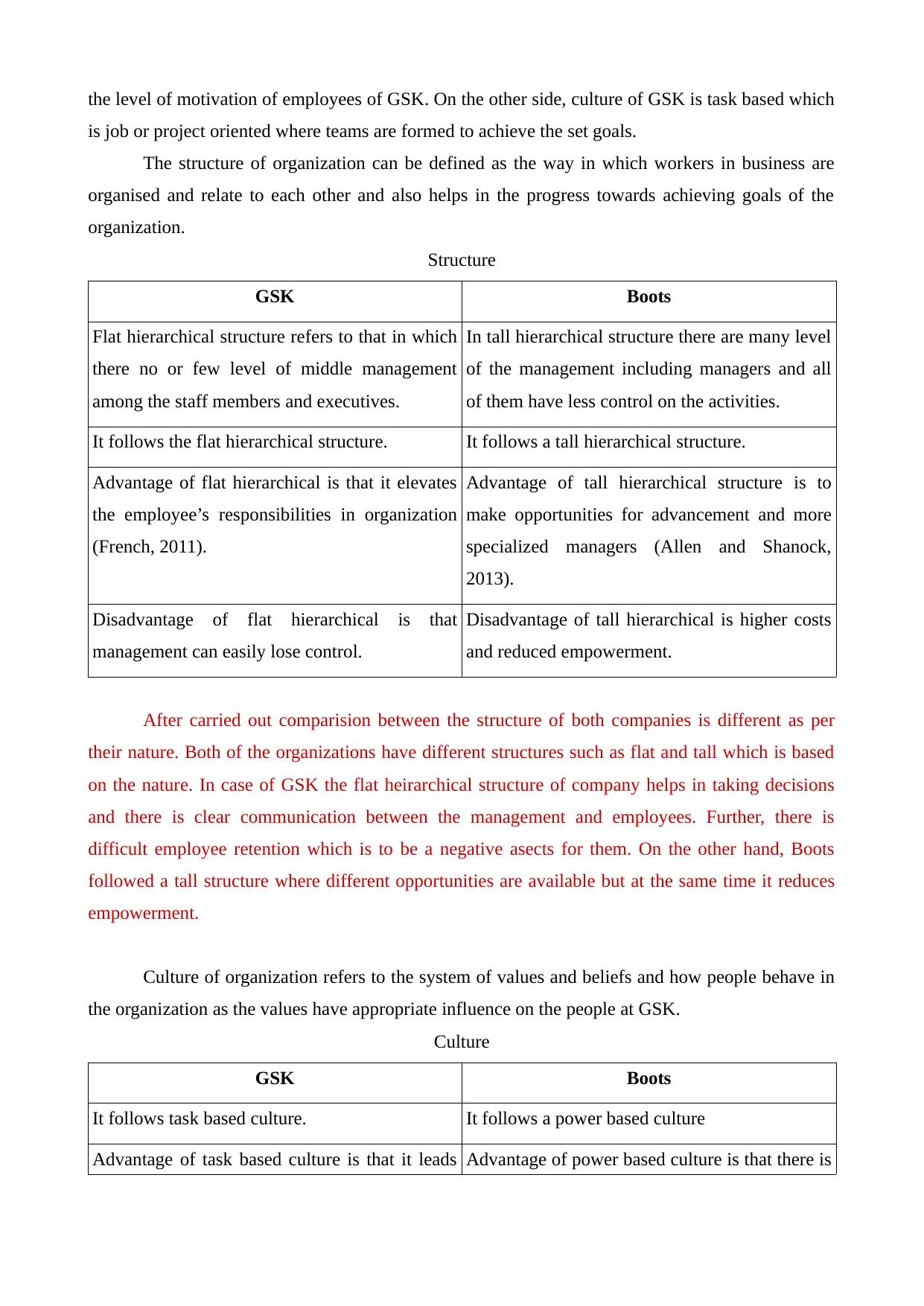
the level of motivation of employees of GSK. On the other side, culture of GSK is task based which
is job or project oriented where teams are formed to achieve the set goals.
The structure of organization can be defined as the way in which workers in business are
organised and relate to each other and also helps in the progress towards achieving goals of the
organization.
Structure
GSK Boots
Flat hierarchical structure refers to that in which
there no or few level of middle management
among the staff members and executives.
In tall hierarchical structure there are many level
of the management including managers and all
of them have less control on the activities.
It follows the flat hierarchical structure. It follows a tall hierarchical structure.
Advantage of flat hierarchical is that it elevates
the employee’s responsibilities in organization
(French, 2011).
Advantage of tall hierarchical structure is to
make opportunities for advancement and more
specialized managers (Allen and Shanock,
2013).
Disadvantage of flat hierarchical is that
management can easily lose control.
Disadvantage of tall hierarchical is higher costs
and reduced empowerment.
After carried out comparision between the structure of both companies is different as per
their nature. Both of the organizations have different structures such as flat and tall which is based
on the nature. In case of GSK the flat heirarchical structure of company helps in taking decisions
and there is clear communication between the management and employees. Further, there is
difficult employee retention which is to be a negative asects for them. On the other hand, Boots
followed a tall structure where different opportunities are available but at the same time it reduces
empowerment.
Culture of organization refers to the system of values and beliefs and how people behave in
the organization as the values have appropriate influence on the people at GSK.
Culture
GSK Boots
It follows task based culture. It follows a power based culture
Advantage of task based culture is that it leads Advantage of power based culture is that there is
is job or project oriented where teams are formed to achieve the set goals.
The structure of organization can be defined as the way in which workers in business are
organised and relate to each other and also helps in the progress towards achieving goals of the
organization.
Structure
GSK Boots
Flat hierarchical structure refers to that in which
there no or few level of middle management
among the staff members and executives.
In tall hierarchical structure there are many level
of the management including managers and all
of them have less control on the activities.
It follows the flat hierarchical structure. It follows a tall hierarchical structure.
Advantage of flat hierarchical is that it elevates
the employee’s responsibilities in organization
(French, 2011).
Advantage of tall hierarchical structure is to
make opportunities for advancement and more
specialized managers (Allen and Shanock,
2013).
Disadvantage of flat hierarchical is that
management can easily lose control.
Disadvantage of tall hierarchical is higher costs
and reduced empowerment.
After carried out comparision between the structure of both companies is different as per
their nature. Both of the organizations have different structures such as flat and tall which is based
on the nature. In case of GSK the flat heirarchical structure of company helps in taking decisions
and there is clear communication between the management and employees. Further, there is
difficult employee retention which is to be a negative asects for them. On the other hand, Boots
followed a tall structure where different opportunities are available but at the same time it reduces
empowerment.
Culture of organization refers to the system of values and beliefs and how people behave in
the organization as the values have appropriate influence on the people at GSK.
Culture
GSK Boots
It follows task based culture. It follows a power based culture
Advantage of task based culture is that it leads Advantage of power based culture is that there is
Paraphrase This Document
Need a fresh take? Get an instant paraphrase of this document with our AI Paraphraser
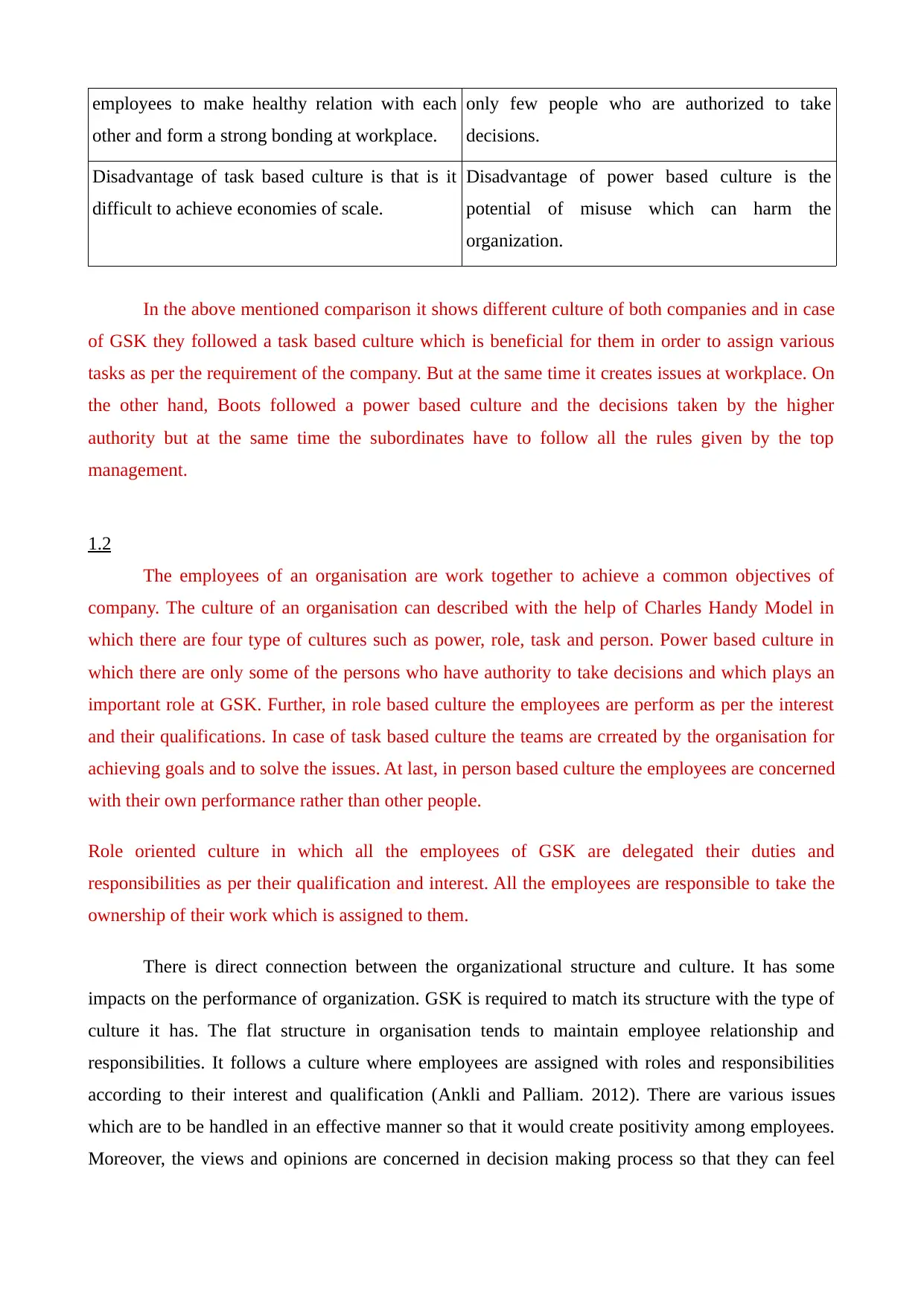
employees to make healthy relation with each
other and form a strong bonding at workplace.
only few people who are authorized to take
decisions.
Disadvantage of task based culture is that is it
difficult to achieve economies of scale.
Disadvantage of power based culture is the
potential of misuse which can harm the
organization.
In the above mentioned comparison it shows different culture of both companies and in case
of GSK they followed a task based culture which is beneficial for them in order to assign various
tasks as per the requirement of the company. But at the same time it creates issues at workplace. On
the other hand, Boots followed a power based culture and the decisions taken by the higher
authority but at the same time the subordinates have to follow all the rules given by the top
management.
1.2
The employees of an organisation are work together to achieve a common objectives of
company. The culture of an organisation can described with the help of Charles Handy Model in
which there are four type of cultures such as power, role, task and person. Power based culture in
which there are only some of the persons who have authority to take decisions and which plays an
important role at GSK. Further, in role based culture the employees are perform as per the interest
and their qualifications. In case of task based culture the teams are crreated by the organisation for
achieving goals and to solve the issues. At last, in person based culture the employees are concerned
with their own performance rather than other people.
Role oriented culture in which all the employees of GSK are delegated their duties and
responsibilities as per their qualification and interest. All the employees are responsible to take the
ownership of their work which is assigned to them.
There is direct connection between the organizational structure and culture. It has some
impacts on the performance of organization. GSK is required to match its structure with the type of
culture it has. The flat structure in organisation tends to maintain employee relationship and
responsibilities. It follows a culture where employees are assigned with roles and responsibilities
according to their interest and qualification (Ankli and Palliam. 2012). There are various issues
which are to be handled in an effective manner so that it would create positivity among employees.
Moreover, the views and opinions are concerned in decision making process so that they can feel
other and form a strong bonding at workplace.
only few people who are authorized to take
decisions.
Disadvantage of task based culture is that is it
difficult to achieve economies of scale.
Disadvantage of power based culture is the
potential of misuse which can harm the
organization.
In the above mentioned comparison it shows different culture of both companies and in case
of GSK they followed a task based culture which is beneficial for them in order to assign various
tasks as per the requirement of the company. But at the same time it creates issues at workplace. On
the other hand, Boots followed a power based culture and the decisions taken by the higher
authority but at the same time the subordinates have to follow all the rules given by the top
management.
1.2
The employees of an organisation are work together to achieve a common objectives of
company. The culture of an organisation can described with the help of Charles Handy Model in
which there are four type of cultures such as power, role, task and person. Power based culture in
which there are only some of the persons who have authority to take decisions and which plays an
important role at GSK. Further, in role based culture the employees are perform as per the interest
and their qualifications. In case of task based culture the teams are crreated by the organisation for
achieving goals and to solve the issues. At last, in person based culture the employees are concerned
with their own performance rather than other people.
Role oriented culture in which all the employees of GSK are delegated their duties and
responsibilities as per their qualification and interest. All the employees are responsible to take the
ownership of their work which is assigned to them.
There is direct connection between the organizational structure and culture. It has some
impacts on the performance of organization. GSK is required to match its structure with the type of
culture it has. The flat structure in organisation tends to maintain employee relationship and
responsibilities. It follows a culture where employees are assigned with roles and responsibilities
according to their interest and qualification (Ankli and Palliam. 2012). There are various issues
which are to be handled in an effective manner so that it would create positivity among employees.
Moreover, the views and opinions are concerned in decision making process so that they can feel
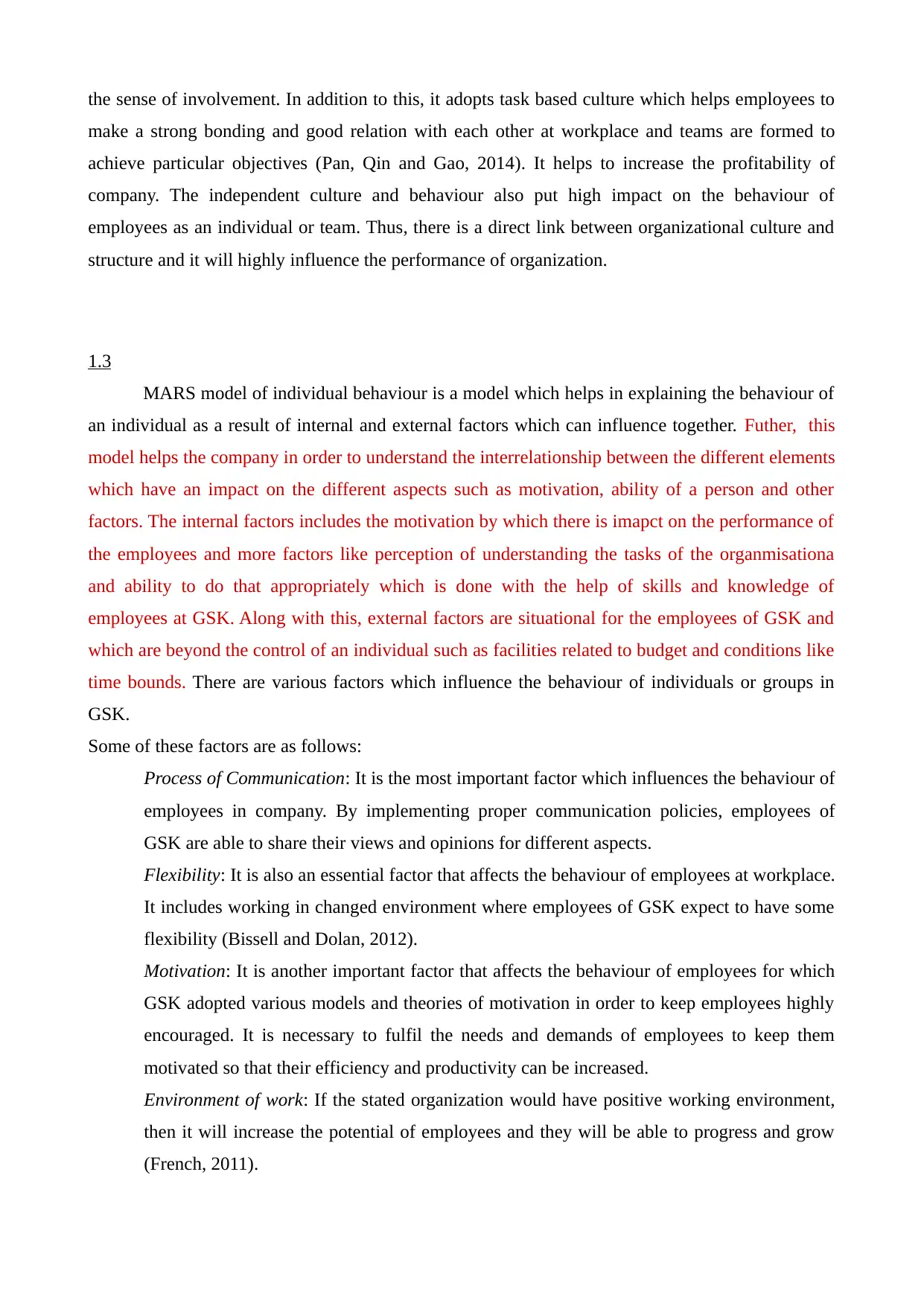
the sense of involvement. In addition to this, it adopts task based culture which helps employees to
make a strong bonding and good relation with each other at workplace and teams are formed to
achieve particular objectives (Pan, Qin and Gao, 2014). It helps to increase the profitability of
company. The independent culture and behaviour also put high impact on the behaviour of
employees as an individual or team. Thus, there is a direct link between organizational culture and
structure and it will highly influence the performance of organization.
1.3
MARS model of individual behaviour is a model which helps in explaining the behaviour of
an individual as a result of internal and external factors which can influence together. Futher, this
model helps the company in order to understand the interrelationship between the different elements
which have an impact on the different aspects such as motivation, ability of a person and other
factors. The internal factors includes the motivation by which there is imapct on the performance of
the employees and more factors like perception of understanding the tasks of the organmisationa
and ability to do that appropriately which is done with the help of skills and knowledge of
employees at GSK. Along with this, external factors are situational for the employees of GSK and
which are beyond the control of an individual such as facilities related to budget and conditions like
time bounds. There are various factors which influence the behaviour of individuals or groups in
GSK.
Some of these factors are as follows:
Process of Communication: It is the most important factor which influences the behaviour of
employees in company. By implementing proper communication policies, employees of
GSK are able to share their views and opinions for different aspects.
Flexibility: It is also an essential factor that affects the behaviour of employees at workplace.
It includes working in changed environment where employees of GSK expect to have some
flexibility (Bissell and Dolan, 2012).
Motivation: It is another important factor that affects the behaviour of employees for which
GSK adopted various models and theories of motivation in order to keep employees highly
encouraged. It is necessary to fulfil the needs and demands of employees to keep them
motivated so that their efficiency and productivity can be increased.
Environment of work: If the stated organization would have positive working environment,
then it will increase the potential of employees and they will be able to progress and grow
(French, 2011).
make a strong bonding and good relation with each other at workplace and teams are formed to
achieve particular objectives (Pan, Qin and Gao, 2014). It helps to increase the profitability of
company. The independent culture and behaviour also put high impact on the behaviour of
employees as an individual or team. Thus, there is a direct link between organizational culture and
structure and it will highly influence the performance of organization.
1.3
MARS model of individual behaviour is a model which helps in explaining the behaviour of
an individual as a result of internal and external factors which can influence together. Futher, this
model helps the company in order to understand the interrelationship between the different elements
which have an impact on the different aspects such as motivation, ability of a person and other
factors. The internal factors includes the motivation by which there is imapct on the performance of
the employees and more factors like perception of understanding the tasks of the organmisationa
and ability to do that appropriately which is done with the help of skills and knowledge of
employees at GSK. Along with this, external factors are situational for the employees of GSK and
which are beyond the control of an individual such as facilities related to budget and conditions like
time bounds. There are various factors which influence the behaviour of individuals or groups in
GSK.
Some of these factors are as follows:
Process of Communication: It is the most important factor which influences the behaviour of
employees in company. By implementing proper communication policies, employees of
GSK are able to share their views and opinions for different aspects.
Flexibility: It is also an essential factor that affects the behaviour of employees at workplace.
It includes working in changed environment where employees of GSK expect to have some
flexibility (Bissell and Dolan, 2012).
Motivation: It is another important factor that affects the behaviour of employees for which
GSK adopted various models and theories of motivation in order to keep employees highly
encouraged. It is necessary to fulfil the needs and demands of employees to keep them
motivated so that their efficiency and productivity can be increased.
Environment of work: If the stated organization would have positive working environment,
then it will increase the potential of employees and they will be able to progress and grow
(French, 2011).
⊘ This is a preview!⊘
Do you want full access?
Subscribe today to unlock all pages.

Trusted by 1+ million students worldwide
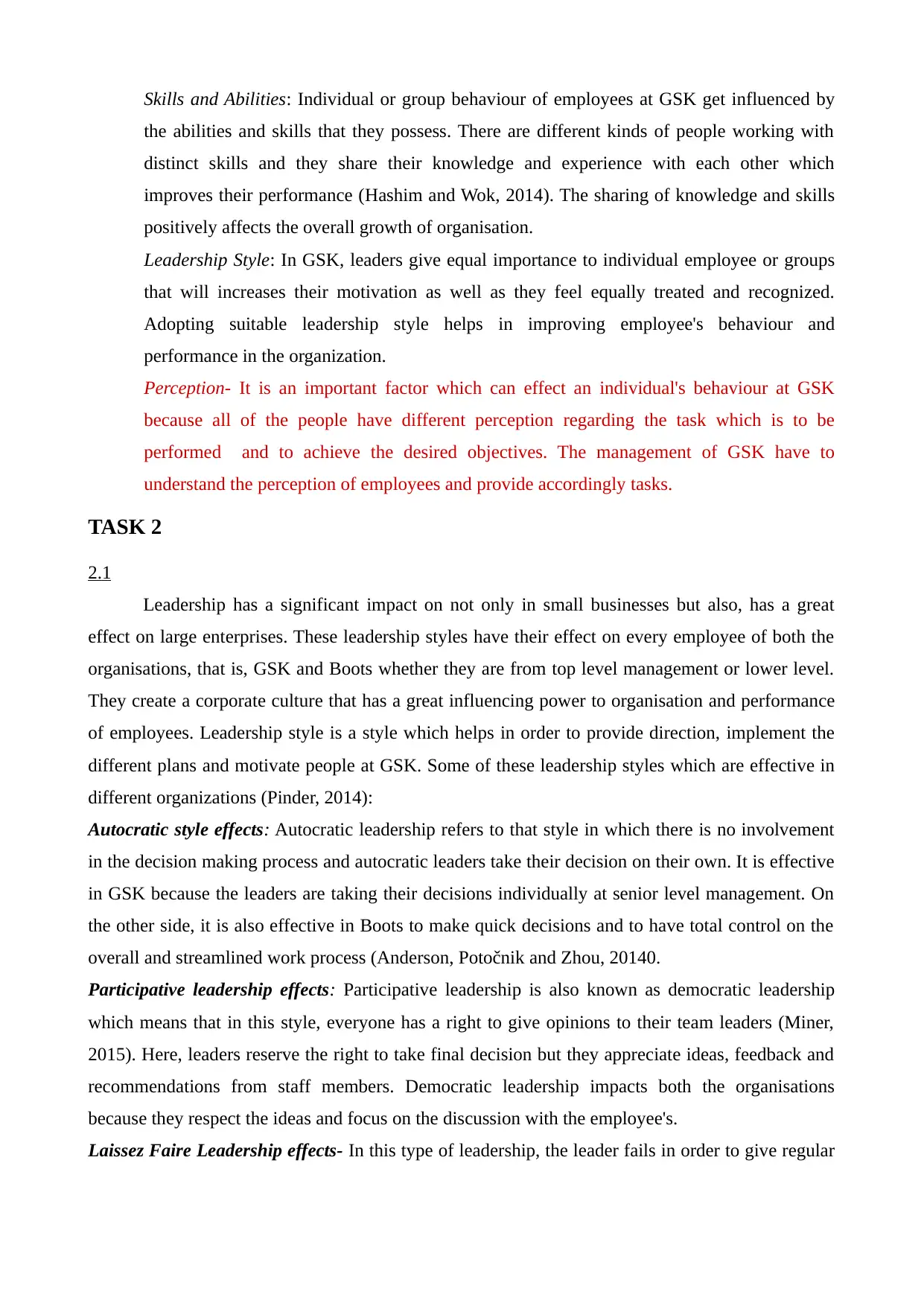
Skills and Abilities: Individual or group behaviour of employees at GSK get influenced by
the abilities and skills that they possess. There are different kinds of people working with
distinct skills and they share their knowledge and experience with each other which
improves their performance (Hashim and Wok, 2014). The sharing of knowledge and skills
positively affects the overall growth of organisation.
Leadership Style: In GSK, leaders give equal importance to individual employee or groups
that will increases their motivation as well as they feel equally treated and recognized.
Adopting suitable leadership style helps in improving employee's behaviour and
performance in the organization.
Perception- It is an important factor which can effect an individual's behaviour at GSK
because all of the people have different perception regarding the task which is to be
performed and to achieve the desired objectives. The management of GSK have to
understand the perception of employees and provide accordingly tasks.
TASK 2
2.1
Leadership has a significant impact on not only in small businesses but also, has a great
effect on large enterprises. These leadership styles have their effect on every employee of both the
organisations, that is, GSK and Boots whether they are from top level management or lower level.
They create a corporate culture that has a great influencing power to organisation and performance
of employees. Leadership style is a style which helps in order to provide direction, implement the
different plans and motivate people at GSK. Some of these leadership styles which are effective in
different organizations (Pinder, 2014):
Autocratic style effects: Autocratic leadership refers to that style in which there is no involvement
in the decision making process and autocratic leaders take their decision on their own. It is effective
in GSK because the leaders are taking their decisions individually at senior level management. On
the other side, it is also effective in Boots to make quick decisions and to have total control on the
overall and streamlined work process (Anderson, Potočnik and Zhou, 20140.
Participative leadership effects: Participative leadership is also known as democratic leadership
which means that in this style, everyone has a right to give opinions to their team leaders (Miner,
2015). Here, leaders reserve the right to take final decision but they appreciate ideas, feedback and
recommendations from staff members. Democratic leadership impacts both the organisations
because they respect the ideas and focus on the discussion with the employee's.
Laissez Faire Leadership effects- In this type of leadership, the leader fails in order to give regular
the abilities and skills that they possess. There are different kinds of people working with
distinct skills and they share their knowledge and experience with each other which
improves their performance (Hashim and Wok, 2014). The sharing of knowledge and skills
positively affects the overall growth of organisation.
Leadership Style: In GSK, leaders give equal importance to individual employee or groups
that will increases their motivation as well as they feel equally treated and recognized.
Adopting suitable leadership style helps in improving employee's behaviour and
performance in the organization.
Perception- It is an important factor which can effect an individual's behaviour at GSK
because all of the people have different perception regarding the task which is to be
performed and to achieve the desired objectives. The management of GSK have to
understand the perception of employees and provide accordingly tasks.
TASK 2
2.1
Leadership has a significant impact on not only in small businesses but also, has a great
effect on large enterprises. These leadership styles have their effect on every employee of both the
organisations, that is, GSK and Boots whether they are from top level management or lower level.
They create a corporate culture that has a great influencing power to organisation and performance
of employees. Leadership style is a style which helps in order to provide direction, implement the
different plans and motivate people at GSK. Some of these leadership styles which are effective in
different organizations (Pinder, 2014):
Autocratic style effects: Autocratic leadership refers to that style in which there is no involvement
in the decision making process and autocratic leaders take their decision on their own. It is effective
in GSK because the leaders are taking their decisions individually at senior level management. On
the other side, it is also effective in Boots to make quick decisions and to have total control on the
overall and streamlined work process (Anderson, Potočnik and Zhou, 20140.
Participative leadership effects: Participative leadership is also known as democratic leadership
which means that in this style, everyone has a right to give opinions to their team leaders (Miner,
2015). Here, leaders reserve the right to take final decision but they appreciate ideas, feedback and
recommendations from staff members. Democratic leadership impacts both the organisations
because they respect the ideas and focus on the discussion with the employee's.
Laissez Faire Leadership effects- In this type of leadership, the leader fails in order to give regular
Paraphrase This Document
Need a fresh take? Get an instant paraphrase of this document with our AI Paraphraser
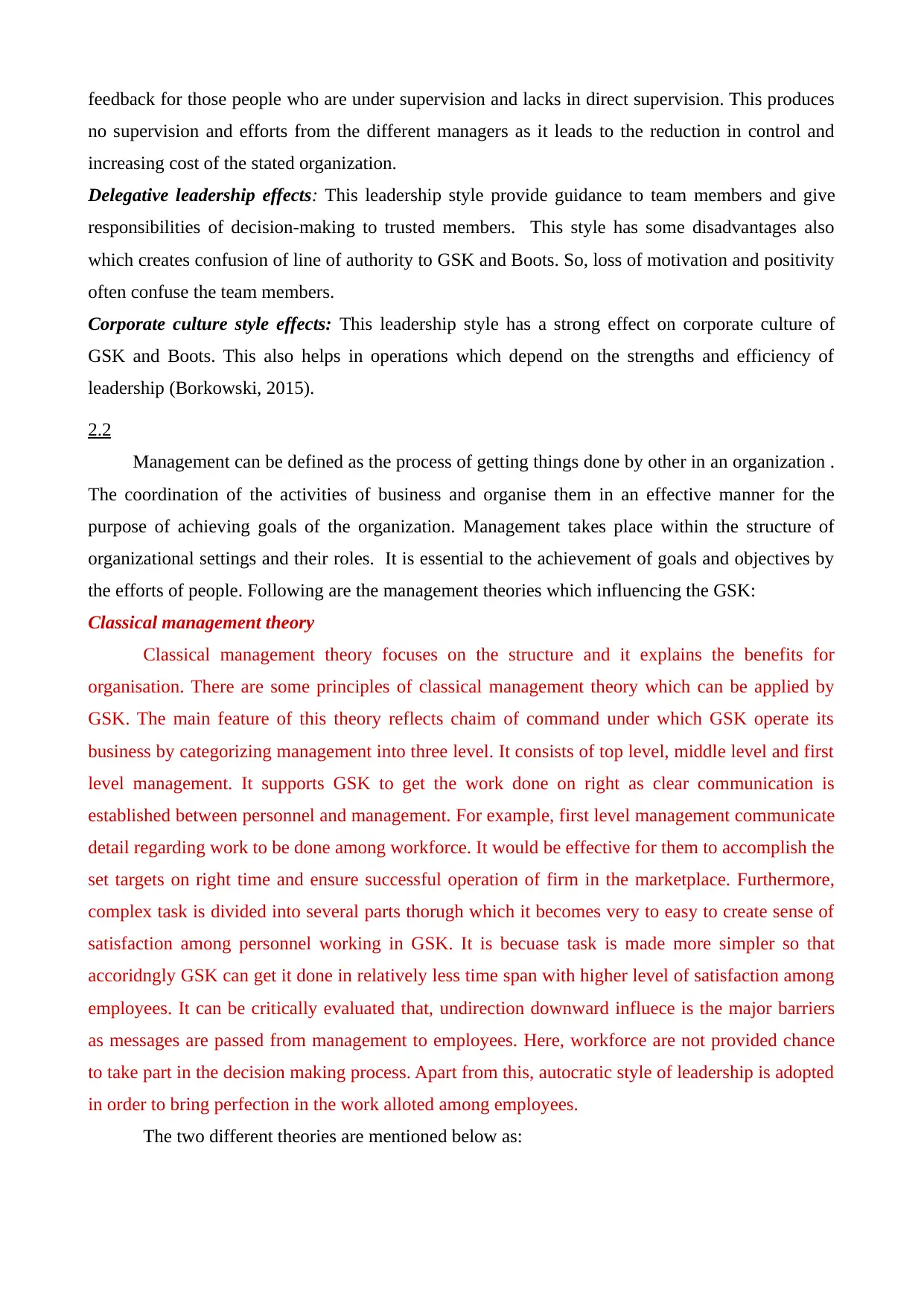
feedback for those people who are under supervision and lacks in direct supervision. This produces
no supervision and efforts from the different managers as it leads to the reduction in control and
increasing cost of the stated organization.
Delegative leadership effects: This leadership style provide guidance to team members and give
responsibilities of decision-making to trusted members. This style has some disadvantages also
which creates confusion of line of authority to GSK and Boots. So, loss of motivation and positivity
often confuse the team members.
Corporate culture style effects: This leadership style has a strong effect on corporate culture of
GSK and Boots. This also helps in operations which depend on the strengths and efficiency of
leadership (Borkowski, 2015).
2.2
Management can be defined as the process of getting things done by other in an organization .
The coordination of the activities of business and organise them in an effective manner for the
purpose of achieving goals of the organization. Management takes place within the structure of
organizational settings and their roles. It is essential to the achievement of goals and objectives by
the efforts of people. Following are the management theories which influencing the GSK:
Classical management theory
Classical management theory focuses on the structure and it explains the benefits for
organisation. There are some principles of classical management theory which can be applied by
GSK. The main feature of this theory reflects chaim of command under which GSK operate its
business by categorizing management into three level. It consists of top level, middle level and first
level management. It supports GSK to get the work done on right as clear communication is
established between personnel and management. For example, first level management communicate
detail regarding work to be done among workforce. It would be effective for them to accomplish the
set targets on right time and ensure successful operation of firm in the marketplace. Furthermore,
complex task is divided into several parts thorugh which it becomes very to easy to create sense of
satisfaction among personnel working in GSK. It is becuase task is made more simpler so that
accoridngly GSK can get it done in relatively less time span with higher level of satisfaction among
employees. It can be critically evaluated that, undirection downward influece is the major barriers
as messages are passed from management to employees. Here, workforce are not provided chance
to take part in the decision making process. Apart from this, autocratic style of leadership is adopted
in order to bring perfection in the work alloted among employees.
The two different theories are mentioned below as:
no supervision and efforts from the different managers as it leads to the reduction in control and
increasing cost of the stated organization.
Delegative leadership effects: This leadership style provide guidance to team members and give
responsibilities of decision-making to trusted members. This style has some disadvantages also
which creates confusion of line of authority to GSK and Boots. So, loss of motivation and positivity
often confuse the team members.
Corporate culture style effects: This leadership style has a strong effect on corporate culture of
GSK and Boots. This also helps in operations which depend on the strengths and efficiency of
leadership (Borkowski, 2015).
2.2
Management can be defined as the process of getting things done by other in an organization .
The coordination of the activities of business and organise them in an effective manner for the
purpose of achieving goals of the organization. Management takes place within the structure of
organizational settings and their roles. It is essential to the achievement of goals and objectives by
the efforts of people. Following are the management theories which influencing the GSK:
Classical management theory
Classical management theory focuses on the structure and it explains the benefits for
organisation. There are some principles of classical management theory which can be applied by
GSK. The main feature of this theory reflects chaim of command under which GSK operate its
business by categorizing management into three level. It consists of top level, middle level and first
level management. It supports GSK to get the work done on right as clear communication is
established between personnel and management. For example, first level management communicate
detail regarding work to be done among workforce. It would be effective for them to accomplish the
set targets on right time and ensure successful operation of firm in the marketplace. Furthermore,
complex task is divided into several parts thorugh which it becomes very to easy to create sense of
satisfaction among personnel working in GSK. It is becuase task is made more simpler so that
accoridngly GSK can get it done in relatively less time span with higher level of satisfaction among
employees. It can be critically evaluated that, undirection downward influece is the major barriers
as messages are passed from management to employees. Here, workforce are not provided chance
to take part in the decision making process. Apart from this, autocratic style of leadership is adopted
in order to bring perfection in the work alloted among employees.
The two different theories are mentioned below as:
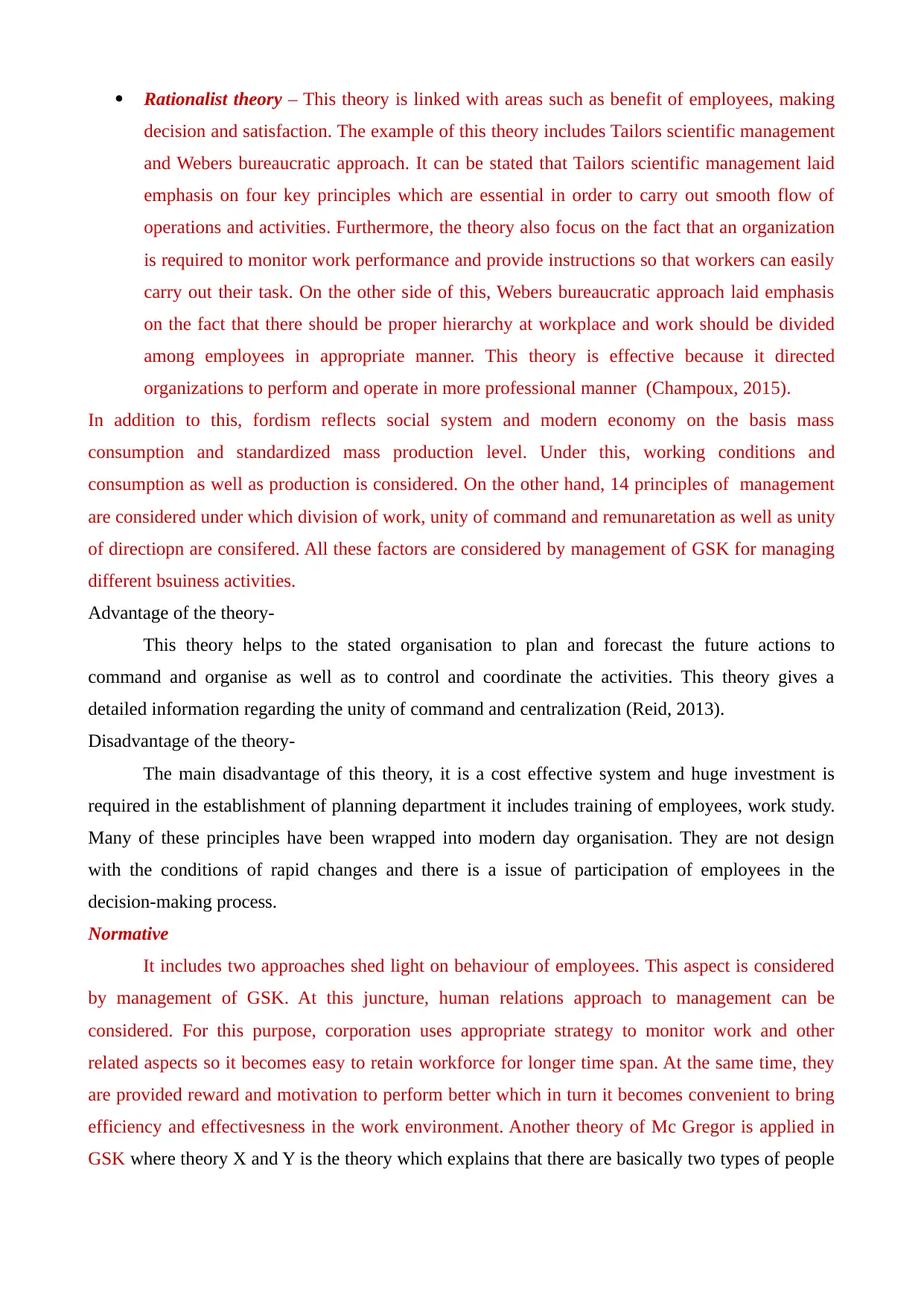
Rationalist theory – This theory is linked with areas such as benefit of employees, making
decision and satisfaction. The example of this theory includes Tailors scientific management
and Webers bureaucratic approach. It can be stated that Tailors scientific management laid
emphasis on four key principles which are essential in order to carry out smooth flow of
operations and activities. Furthermore, the theory also focus on the fact that an organization
is required to monitor work performance and provide instructions so that workers can easily
carry out their task. On the other side of this, Webers bureaucratic approach laid emphasis
on the fact that there should be proper hierarchy at workplace and work should be divided
among employees in appropriate manner. This theory is effective because it directed
organizations to perform and operate in more professional manner (Champoux, 2015).
In addition to this, fordism reflects social system and modern economy on the basis mass
consumption and standardized mass production level. Under this, working conditions and
consumption as well as production is considered. On the other hand, 14 principles of management
are considered under which division of work, unity of command and remunaretation as well as unity
of directiopn are consifered. All these factors are considered by management of GSK for managing
different bsuiness activities.
Advantage of the theory-
This theory helps to the stated organisation to plan and forecast the future actions to
command and organise as well as to control and coordinate the activities. This theory gives a
detailed information regarding the unity of command and centralization (Reid, 2013).
Disadvantage of the theory-
The main disadvantage of this theory, it is a cost effective system and huge investment is
required in the establishment of planning department it includes training of employees, work study.
Many of these principles have been wrapped into modern day organisation. They are not design
with the conditions of rapid changes and there is a issue of participation of employees in the
decision-making process.
Normative
It includes two approaches shed light on behaviour of employees. This aspect is considered
by management of GSK. At this juncture, human relations approach to management can be
considered. For this purpose, corporation uses appropriate strategy to monitor work and other
related aspects so it becomes easy to retain workforce for longer time span. At the same time, they
are provided reward and motivation to perform better which in turn it becomes convenient to bring
efficiency and effectivesness in the work environment. Another theory of Mc Gregor is applied in
GSK where theory X and Y is the theory which explains that there are basically two types of people
decision and satisfaction. The example of this theory includes Tailors scientific management
and Webers bureaucratic approach. It can be stated that Tailors scientific management laid
emphasis on four key principles which are essential in order to carry out smooth flow of
operations and activities. Furthermore, the theory also focus on the fact that an organization
is required to monitor work performance and provide instructions so that workers can easily
carry out their task. On the other side of this, Webers bureaucratic approach laid emphasis
on the fact that there should be proper hierarchy at workplace and work should be divided
among employees in appropriate manner. This theory is effective because it directed
organizations to perform and operate in more professional manner (Champoux, 2015).
In addition to this, fordism reflects social system and modern economy on the basis mass
consumption and standardized mass production level. Under this, working conditions and
consumption as well as production is considered. On the other hand, 14 principles of management
are considered under which division of work, unity of command and remunaretation as well as unity
of directiopn are consifered. All these factors are considered by management of GSK for managing
different bsuiness activities.
Advantage of the theory-
This theory helps to the stated organisation to plan and forecast the future actions to
command and organise as well as to control and coordinate the activities. This theory gives a
detailed information regarding the unity of command and centralization (Reid, 2013).
Disadvantage of the theory-
The main disadvantage of this theory, it is a cost effective system and huge investment is
required in the establishment of planning department it includes training of employees, work study.
Many of these principles have been wrapped into modern day organisation. They are not design
with the conditions of rapid changes and there is a issue of participation of employees in the
decision-making process.
Normative
It includes two approaches shed light on behaviour of employees. This aspect is considered
by management of GSK. At this juncture, human relations approach to management can be
considered. For this purpose, corporation uses appropriate strategy to monitor work and other
related aspects so it becomes easy to retain workforce for longer time span. At the same time, they
are provided reward and motivation to perform better which in turn it becomes convenient to bring
efficiency and effectivesness in the work environment. Another theory of Mc Gregor is applied in
GSK where theory X and Y is the theory which explains that there are basically two types of people
⊘ This is a preview!⊘
Do you want full access?
Subscribe today to unlock all pages.

Trusted by 1+ million students worldwide
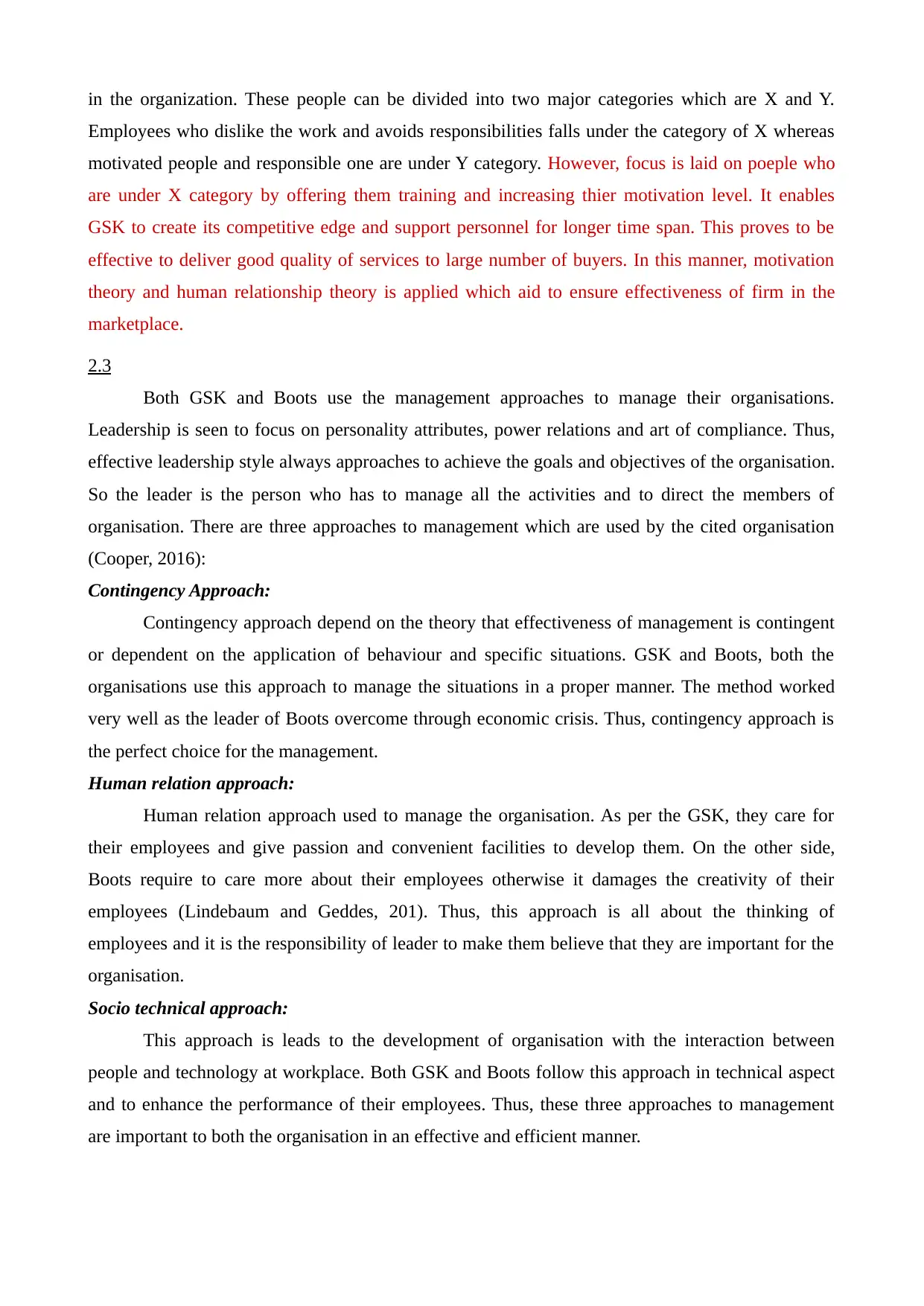
in the organization. These people can be divided into two major categories which are X and Y.
Employees who dislike the work and avoids responsibilities falls under the category of X whereas
motivated people and responsible one are under Y category. However, focus is laid on poeple who
are under X category by offering them training and increasing thier motivation level. It enables
GSK to create its competitive edge and support personnel for longer time span. This proves to be
effective to deliver good quality of services to large number of buyers. In this manner, motivation
theory and human relationship theory is applied which aid to ensure effectiveness of firm in the
marketplace.
2.3
Both GSK and Boots use the management approaches to manage their organisations.
Leadership is seen to focus on personality attributes, power relations and art of compliance. Thus,
effective leadership style always approaches to achieve the goals and objectives of the organisation.
So the leader is the person who has to manage all the activities and to direct the members of
organisation. There are three approaches to management which are used by the cited organisation
(Cooper, 2016):
Contingency Approach:
Contingency approach depend on the theory that effectiveness of management is contingent
or dependent on the application of behaviour and specific situations. GSK and Boots, both the
organisations use this approach to manage the situations in a proper manner. The method worked
very well as the leader of Boots overcome through economic crisis. Thus, contingency approach is
the perfect choice for the management.
Human relation approach:
Human relation approach used to manage the organisation. As per the GSK, they care for
their employees and give passion and convenient facilities to develop them. On the other side,
Boots require to care more about their employees otherwise it damages the creativity of their
employees (Lindebaum and Geddes, 201). Thus, this approach is all about the thinking of
employees and it is the responsibility of leader to make them believe that they are important for the
organisation.
Socio technical approach:
This approach is leads to the development of organisation with the interaction between
people and technology at workplace. Both GSK and Boots follow this approach in technical aspect
and to enhance the performance of their employees. Thus, these three approaches to management
are important to both the organisation in an effective and efficient manner.
Employees who dislike the work and avoids responsibilities falls under the category of X whereas
motivated people and responsible one are under Y category. However, focus is laid on poeple who
are under X category by offering them training and increasing thier motivation level. It enables
GSK to create its competitive edge and support personnel for longer time span. This proves to be
effective to deliver good quality of services to large number of buyers. In this manner, motivation
theory and human relationship theory is applied which aid to ensure effectiveness of firm in the
marketplace.
2.3
Both GSK and Boots use the management approaches to manage their organisations.
Leadership is seen to focus on personality attributes, power relations and art of compliance. Thus,
effective leadership style always approaches to achieve the goals and objectives of the organisation.
So the leader is the person who has to manage all the activities and to direct the members of
organisation. There are three approaches to management which are used by the cited organisation
(Cooper, 2016):
Contingency Approach:
Contingency approach depend on the theory that effectiveness of management is contingent
or dependent on the application of behaviour and specific situations. GSK and Boots, both the
organisations use this approach to manage the situations in a proper manner. The method worked
very well as the leader of Boots overcome through economic crisis. Thus, contingency approach is
the perfect choice for the management.
Human relation approach:
Human relation approach used to manage the organisation. As per the GSK, they care for
their employees and give passion and convenient facilities to develop them. On the other side,
Boots require to care more about their employees otherwise it damages the creativity of their
employees (Lindebaum and Geddes, 201). Thus, this approach is all about the thinking of
employees and it is the responsibility of leader to make them believe that they are important for the
organisation.
Socio technical approach:
This approach is leads to the development of organisation with the interaction between
people and technology at workplace. Both GSK and Boots follow this approach in technical aspect
and to enhance the performance of their employees. Thus, these three approaches to management
are important to both the organisation in an effective and efficient manner.
Paraphrase This Document
Need a fresh take? Get an instant paraphrase of this document with our AI Paraphraser
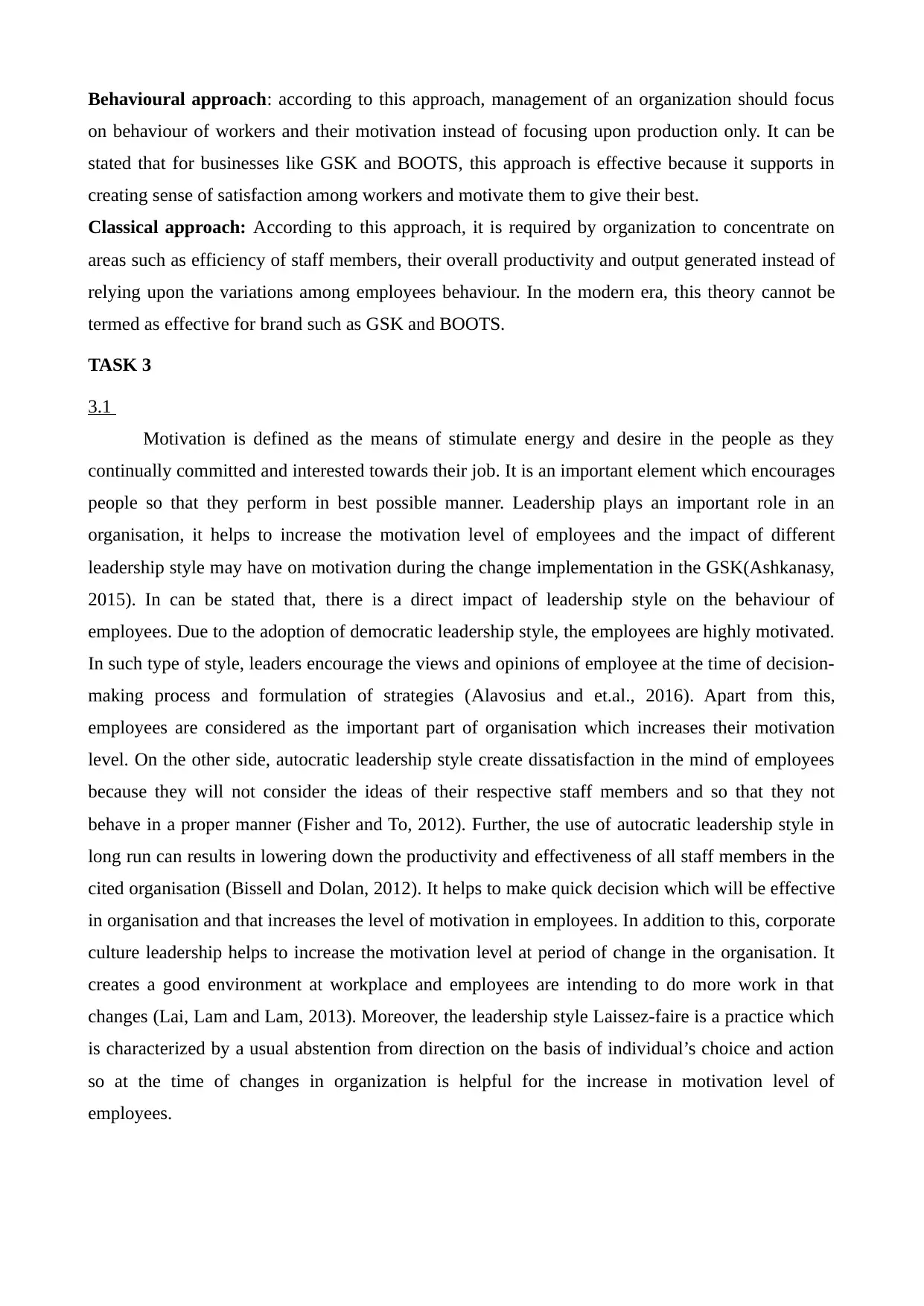
Behavioural approach: according to this approach, management of an organization should focus
on behaviour of workers and their motivation instead of focusing upon production only. It can be
stated that for businesses like GSK and BOOTS, this approach is effective because it supports in
creating sense of satisfaction among workers and motivate them to give their best.
Classical approach: According to this approach, it is required by organization to concentrate on
areas such as efficiency of staff members, their overall productivity and output generated instead of
relying upon the variations among employees behaviour. In the modern era, this theory cannot be
termed as effective for brand such as GSK and BOOTS.
TASK 3
3.1
Motivation is defined as the means of stimulate energy and desire in the people as they
continually committed and interested towards their job. It is an important element which encourages
people so that they perform in best possible manner. Leadership plays an important role in an
organisation, it helps to increase the motivation level of employees and the impact of different
leadership style may have on motivation during the change implementation in the GSK(Ashkanasy,
2015). In can be stated that, there is a direct impact of leadership style on the behaviour of
employees. Due to the adoption of democratic leadership style, the employees are highly motivated.
In such type of style, leaders encourage the views and opinions of employee at the time of decision-
making process and formulation of strategies (Alavosius and et.al., 2016). Apart from this,
employees are considered as the important part of organisation which increases their motivation
level. On the other side, autocratic leadership style create dissatisfaction in the mind of employees
because they will not consider the ideas of their respective staff members and so that they not
behave in a proper manner (Fisher and To, 2012). Further, the use of autocratic leadership style in
long run can results in lowering down the productivity and effectiveness of all staff members in the
cited organisation (Bissell and Dolan, 2012). It helps to make quick decision which will be effective
in organisation and that increases the level of motivation in employees. In addition to this, corporate
culture leadership helps to increase the motivation level at period of change in the organisation. It
creates a good environment at workplace and employees are intending to do more work in that
changes (Lai, Lam and Lam, 2013). Moreover, the leadership style Laissez-faire is a practice which
is characterized by a usual abstention from direction on the basis of individual’s choice and action
so at the time of changes in organization is helpful for the increase in motivation level of
employees.
on behaviour of workers and their motivation instead of focusing upon production only. It can be
stated that for businesses like GSK and BOOTS, this approach is effective because it supports in
creating sense of satisfaction among workers and motivate them to give their best.
Classical approach: According to this approach, it is required by organization to concentrate on
areas such as efficiency of staff members, their overall productivity and output generated instead of
relying upon the variations among employees behaviour. In the modern era, this theory cannot be
termed as effective for brand such as GSK and BOOTS.
TASK 3
3.1
Motivation is defined as the means of stimulate energy and desire in the people as they
continually committed and interested towards their job. It is an important element which encourages
people so that they perform in best possible manner. Leadership plays an important role in an
organisation, it helps to increase the motivation level of employees and the impact of different
leadership style may have on motivation during the change implementation in the GSK(Ashkanasy,
2015). In can be stated that, there is a direct impact of leadership style on the behaviour of
employees. Due to the adoption of democratic leadership style, the employees are highly motivated.
In such type of style, leaders encourage the views and opinions of employee at the time of decision-
making process and formulation of strategies (Alavosius and et.al., 2016). Apart from this,
employees are considered as the important part of organisation which increases their motivation
level. On the other side, autocratic leadership style create dissatisfaction in the mind of employees
because they will not consider the ideas of their respective staff members and so that they not
behave in a proper manner (Fisher and To, 2012). Further, the use of autocratic leadership style in
long run can results in lowering down the productivity and effectiveness of all staff members in the
cited organisation (Bissell and Dolan, 2012). It helps to make quick decision which will be effective
in organisation and that increases the level of motivation in employees. In addition to this, corporate
culture leadership helps to increase the motivation level at period of change in the organisation. It
creates a good environment at workplace and employees are intending to do more work in that
changes (Lai, Lam and Lam, 2013). Moreover, the leadership style Laissez-faire is a practice which
is characterized by a usual abstention from direction on the basis of individual’s choice and action
so at the time of changes in organization is helpful for the increase in motivation level of
employees.
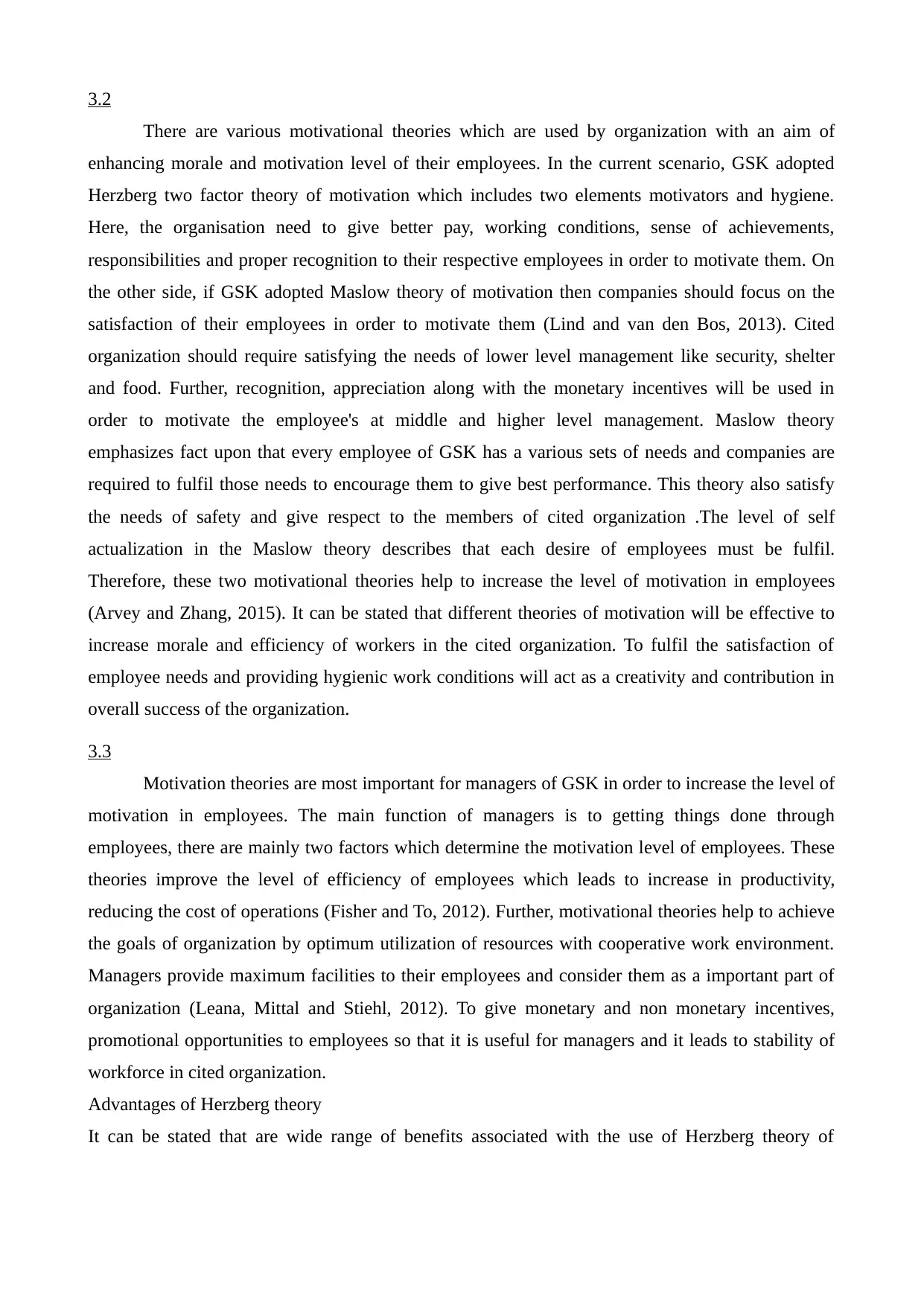
3.2
There are various motivational theories which are used by organization with an aim of
enhancing morale and motivation level of their employees. In the current scenario, GSK adopted
Herzberg two factor theory of motivation which includes two elements motivators and hygiene.
Here, the organisation need to give better pay, working conditions, sense of achievements,
responsibilities and proper recognition to their respective employees in order to motivate them. On
the other side, if GSK adopted Maslow theory of motivation then companies should focus on the
satisfaction of their employees in order to motivate them (Lind and van den Bos, 2013). Cited
organization should require satisfying the needs of lower level management like security, shelter
and food. Further, recognition, appreciation along with the monetary incentives will be used in
order to motivate the employee's at middle and higher level management. Maslow theory
emphasizes fact upon that every employee of GSK has a various sets of needs and companies are
required to fulfil those needs to encourage them to give best performance. This theory also satisfy
the needs of safety and give respect to the members of cited organization .The level of self
actualization in the Maslow theory describes that each desire of employees must be fulfil.
Therefore, these two motivational theories help to increase the level of motivation in employees
(Arvey and Zhang, 2015). It can be stated that different theories of motivation will be effective to
increase morale and efficiency of workers in the cited organization. To fulfil the satisfaction of
employee needs and providing hygienic work conditions will act as a creativity and contribution in
overall success of the organization.
3.3
Motivation theories are most important for managers of GSK in order to increase the level of
motivation in employees. The main function of managers is to getting things done through
employees, there are mainly two factors which determine the motivation level of employees. These
theories improve the level of efficiency of employees which leads to increase in productivity,
reducing the cost of operations (Fisher and To, 2012). Further, motivational theories help to achieve
the goals of organization by optimum utilization of resources with cooperative work environment.
Managers provide maximum facilities to their employees and consider them as a important part of
organization (Leana, Mittal and Stiehl, 2012). To give monetary and non monetary incentives,
promotional opportunities to employees so that it is useful for managers and it leads to stability of
workforce in cited organization.
Advantages of Herzberg theory
It can be stated that are wide range of benefits associated with the use of Herzberg theory of
There are various motivational theories which are used by organization with an aim of
enhancing morale and motivation level of their employees. In the current scenario, GSK adopted
Herzberg two factor theory of motivation which includes two elements motivators and hygiene.
Here, the organisation need to give better pay, working conditions, sense of achievements,
responsibilities and proper recognition to their respective employees in order to motivate them. On
the other side, if GSK adopted Maslow theory of motivation then companies should focus on the
satisfaction of their employees in order to motivate them (Lind and van den Bos, 2013). Cited
organization should require satisfying the needs of lower level management like security, shelter
and food. Further, recognition, appreciation along with the monetary incentives will be used in
order to motivate the employee's at middle and higher level management. Maslow theory
emphasizes fact upon that every employee of GSK has a various sets of needs and companies are
required to fulfil those needs to encourage them to give best performance. This theory also satisfy
the needs of safety and give respect to the members of cited organization .The level of self
actualization in the Maslow theory describes that each desire of employees must be fulfil.
Therefore, these two motivational theories help to increase the level of motivation in employees
(Arvey and Zhang, 2015). It can be stated that different theories of motivation will be effective to
increase morale and efficiency of workers in the cited organization. To fulfil the satisfaction of
employee needs and providing hygienic work conditions will act as a creativity and contribution in
overall success of the organization.
3.3
Motivation theories are most important for managers of GSK in order to increase the level of
motivation in employees. The main function of managers is to getting things done through
employees, there are mainly two factors which determine the motivation level of employees. These
theories improve the level of efficiency of employees which leads to increase in productivity,
reducing the cost of operations (Fisher and To, 2012). Further, motivational theories help to achieve
the goals of organization by optimum utilization of resources with cooperative work environment.
Managers provide maximum facilities to their employees and consider them as a important part of
organization (Leana, Mittal and Stiehl, 2012). To give monetary and non monetary incentives,
promotional opportunities to employees so that it is useful for managers and it leads to stability of
workforce in cited organization.
Advantages of Herzberg theory
It can be stated that are wide range of benefits associated with the use of Herzberg theory of
⊘ This is a preview!⊘
Do you want full access?
Subscribe today to unlock all pages.

Trusted by 1+ million students worldwide
1 out of 19
Related Documents
Your All-in-One AI-Powered Toolkit for Academic Success.
+13062052269
info@desklib.com
Available 24*7 on WhatsApp / Email
![[object Object]](/_next/static/media/star-bottom.7253800d.svg)
Unlock your academic potential
Copyright © 2020–2025 A2Z Services. All Rights Reserved. Developed and managed by ZUCOL.





